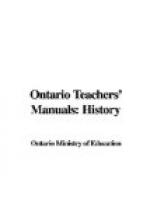THE CHRONOLOGICAL METHOD
The matter is chosen according to the “time” order, beginning at the first of the history, and the events are taught in the order of occurrence without any marked emphasis on their importance, or without considering whether a knowledge of the event is useful or interesting to the class at this stage. Such an arrangement of matter is more suitable when the formal study of history is begun.
THE TOPICAL METHOD
In studying a certain period of history the events are arranged under topics or heads; for example, the period of discovery in Canadian History may be arranged thus—Discoveries, Explorations, Early Settlements, Indian Wars—and the study of each of these pursued to completion, contemporary events belonging to other topics being neglected for a time.
Events having the same underlying purpose, though occurring in different periods, may be arranged under one topic for review; for example, all the voyages of discovery to America may be grouped under the topic, “The Road to Cathay.” (See p. 92.) In this way a comprehensive knowledge is gained. This method gives a full treatment of each topic and may be used to best advantage in connection with reviews in junior classes and occasionally as a text-book or library exercise in senior classes.
2. Methods based on the treatment of historical facts: Comparative, Regressive, Concentric
THE COMPARATIVE METHOD
By this method a comparison is made between two events, two biographies, two reigns, etc., a very useful device when applied in connection with other methods.
THE REGRESSIVE METHOD
In this method the pupil is expected to begin with the present and work backward; that is, to begin with institutions as they are to-day and to work back through the various steps in their progress to their present state. This method may be followed most profitably in advanced classes. In junior classes it is sufficient to refer to things as they exist to-day in order to arouse curiosity regarding the facts of history that are to be taught; for example, by the use of local material; by a visit to some place of historical interest to prepare for the story of what has occurred there in the past. (See p. 112.)
THE CONCENTRIC METHOD
This method, which is much used, deals in ever widening circles with the same topic or event; for example, a simple story of Champlain’s life and voyages to Canada is told to Form II; the same story is considered again in Form III, but this time the different voyages are noted, the results of each investigated, and the whole summarized and memorized; again, in Form IV, but this time by the topical and comparative methods, where comparison is made of the purposes and achievements of the explorer with those of other explorers—Jacques Cartier, La Salle, etc. In this third discussion a full knowledge of Champlain’s work is given.




